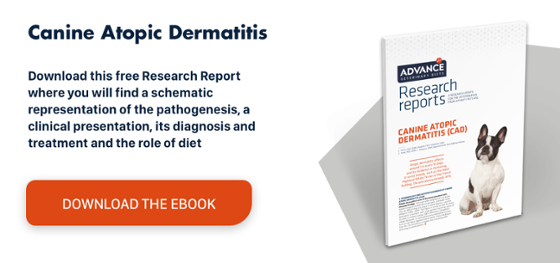Skin allergies in dogs: do they affect the kinetics of topical hydrocortisone?
Skin allergies in dogs are a relatively common problem and their incidence is growing. Some breeds are more predisposed, such as the French Bulldog and West Highland White Terrier. In the case of atopic dermatitis, the most common cause is environmental allergens, usually dust mites, although it may also be due to pollen or certain foods, as indicated in a study conducted at the University of Edinburgh.1
As the problem becomes chronic, erythema gives way to zones of hypotrichosis, due to scratching, and hyperpigmentation until finally lichenification develops. In chronic phases, the skin barrier is compromised by both inflammation and secondary infections.
Hydrocortisone and skin allergies
Skin allergies in dogs can be treated with different therapeutic approaches, including the use of glucocorticoids such as hydrocortisone. Glucocorticoids work by reducing the inflammation and pruritus, so the patient scratches less and suffers less skin irritation. This therapy is recommended when the inflammation is localised, usually in mild cases, although it can also be applied in chronic phases after systemic therapy has controlled the main clinical signs.
Hydrocortisone accumulates in the skin, so it provides local efficacy at low doses and generally leads to rapid improvement of the skin lesions typical of inflammatory and pruritic dermatosis.
A study conducted at the University of Queensland2 precisely analysed the effect of allergic skin diseases on the penetration kinetics of hydrocortisone in canine skin in vitro. An alteration in the transdermal penetration of hydrocortisone was observed in damaged and normal skin fragments taken from the thoracodorsal and lumbosacral regions of 5 dog cadavers affected by flea allergy dermatitis.
After applying a saturated solution of hydrocortisone and evaluating its action for over 30 hours, the researchers found that transdermal penetration can increase by a factor of 2–10 in comparison with healthy skin. Although the authors highlighted that these results may be mediated by variables such as disease severity, concurrent infections and interindividual differences in skin characteristics, it is important to note that the topical application of glucocorticoids to skin damaged by an allergy may result in more penetration than expected and consequently more systemic side effects.
Ceramides in the treatment of skin allergies
In healthy skin, keratinocytes secrete ceramides into the intercellular space, as they contain n-6 linoleic acid which ensures cell cohesion and the effectiveness of the skin barrier. However, skin problems such as atopic dermatitis cause changes in lipid organisation in the stratum corneum. According to a study carried out at the University of Cornell,3 there is a reduction in n-6 linoleic acid and n-3 α-linoleic metabolites due to a deficit in the activity of ∆-5 and ∆-6 desaturase enzymes in the epidermis.
Affinity4 research on an artificial canine skin model analysed the effect of the oral administration of different functional ingredients on skin health. A diet with omega-6 (n-6) essential fatty acids ensures cohesion of the epidermis, helps keep the skin barrier hydrated and provides precursors of eicosanoids and other components and mediators of cell function.
This indicates that a suitable diet, such as ATOPIC and ATOPICRABBIT, can improve skin barrier function, stimulate healing and reduce the allergic inflammatory response and pruritus, so it is recommendable as part of the general support measures to complement more specific therapeutic interventions for skin allergies in dogs.


